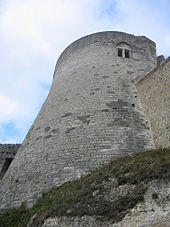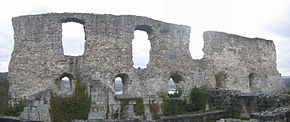Château Gaillard
The Château Gaillard is a late 12th century by Richard the Lionheart , King of England and Duke of Normandy , was built, but already in the Middle Ages and in the early modern period destroyed castle in the center of Vexin normand in the Eure in Normandy . The complex, which is one of the most important castles of the Middle Ages, is based on the crusader castles of Palestine and cost the enormous sum of around 50,000 livres at the time .
As early as 1862, the ruins of Château Gaillard were included in the list of Monuments historiques .
Location and facility
The Château Gaillard rises on a limestone rock above a loop of the Seine near the small town of Les Andelys approx. 44 km (driving distance) southeast of Rouen and approx. 100 km northwest of Paris .
The defense system built by Richard, which literally blocked the river, consisted of much more than the fortress that can still be seen today: on the plateau there were a number of outposts and other fortified points on moths surrounded by moats . In the valley between the two fortified towns of Petit and Grand Andely, which today form the municipality of Les Andelys, there was a marshland, on the other side of the river a network of trenches and a fortified island in the river, over which chains were stretched. Where the current bridge is located, wooden posts were placed in the water to prevent ships from passing through. The center of the defense system was finally the Château Gaillard.
The height of the limestone rock made it necessary to drill 120 m deep - 20 m below the level of the Seine - for the construction of the three wells , but also made it possible to create a large number of cellars to store sufficient supplies in the event of a siege .
Because the range of the siege weapons at that time was relatively small, the castle did not need to be built on the highest point; Richard had a system built around Cléry's moth there in order to keep this place open for the future.
architecture
The architecture of the complex is largely influenced by the crusader castles (especially Krak des Chevaliers ), which Richard had got to know in the Holy Land , and turned out to be extremely modern for the time: There was a five-tower bailey and one of numerous semicircular ones lined up next to one another and the main castle formed by sloping towers in the lower part , which in turn enclosed the donjon . The outer bailey and the tower ring of the main castle prevented hits in the donjon, which is still in a comparatively intact condition - albeit without a roof. A spur-like point of the wall at the base of the donjon points in the main direction of attack.
Although there is no clear evidence, the Château Gaillard seems to have been the first castle complex in Europe with pronounced embankments and machicolations , as they can also be found in pronounced form on the Krak des Chevaliers.
history

Richard the Lionheart, former ally of the French King Philip Augustus against his father Henry II , went on the Third Crusade after he had inherited the crown of England . After his return in 1194 he devoted himself with great energy to the task of regaining supremacy on the eastern border of Normandy. After defeating the French army at the Battle of Vendôme , he benefited from the peace that the Pope ordered to carry out one of his projects in record time: the construction of the border fortress Château Gaillard began in 1196 and was completed just a few years later completed.
First siege
When Richard died in April 1199, his brother Johann Ohneland followed him on the throne in Normandy. In the Treaty of Le Goulet , Philipp August had to recognize Johann as heir to Richard the Lionheart on May 22, 1200, but two years later another war between France and England began . Philip August attacked Normandy and began the siege of Château Gaillard with 6,000 men on August 10, 1203, after he had seized the fortress on the island and Petit Andelys, and now tried to control the garrison and the population who were in the Castle had withdrawn to starve.
Roger de Lacy , the commander of the garrison, fended off all attacks, attempts at storming and arson for seven months, until hunger in the castle took over and three quarters of his men were killed. The old people, women and children from Petit Andely, who had found refuge in the castle, had gradually been driven out by December; the besiegers let the first of them through, but then Philip decided not to let them pass and they starved to death, trapped between the palisades and the walls of the two camps.
Tired of the Anglo- Norman resistance, Philip August ended the siege by ordering a storm attack, with which his troops gradually seized all parts of the castle. According to tradition, the French penetrated through the latrines in the lower courtyard, but in fact they seem to have entered through one of the low windows of the chapel, which Johann Ohneland had built despite being advised. The garrison surrendered on March 6, 1204, clearing the way for the French to complete the conquest of Normandy by June of that year.
14th Century
At the foot of the donjon on the north side there is a staircase that leads to a large cell. According to the historian Édouard Gachot, Margaret of Burgundy , the accused of adultery Louis X. , known as “the brawler” , was imprisoned in this vaulted cellar on June 18, 1314 . After her death on August 15, 1315 her body to the cemetery of the Cordeliers of Vernon brought.
As a result of the scandal surrounding the Tour de Nesle , in addition to Margarete, Blanka of Burgundy , the wife of Charles IV and also a daughter-in-law of King Philip IV , was imprisoned in Château Gaillard. However, she was "allowed" to retire to a monastery.
Hundred Years War
During the Hundred Years' War (1337-1453) was here on the orders of King John II. Of France whose son King Charles II. Of Navarre imprisoned (a grandson of Margaret), but which in 1357, after the defeat of France in the Battle of Maupertuis , again was released , although there are different statements about the circumstances. On the one hand, it is reported that he was able to flee on November 9, 1357, and on the other hand, that the Estates General gathered shortly after the battle and decided to release Charles, in the hope that he would leave the country as Johann's cousin and son-in-law after the defeat would protect.
During this time, Château Gaillard experienced a series of sieges: In 1417, after 16 months, the castle fell into the hands of the English, after the last cable of the well was torn and the castle was without water supply. Étienne de Vignolles , known as La Hire, companion in arms of Jeanne d'Arcs , conquered it in 1429. In 1430 it came under English control again, but in 1449 it came back into the possession of the French.
Modern times
After the last siege of Château Gaillard by Henry of Navarre , later King Henry IV, the order was made to demolish the fortress and hand it over to the monks of Les Andelys. The demolition was interrupted in 1611 but then resumed under Cardinal Richelieu .
literature
- Joseph Decaëns: Le Château-Gaillard. In: L'architecture normande au Moyen Âge. Presses Universitaires de Caen, 1997, Vol. 2, pp. 285-287.
- Dominique Pitte: The prize de Château-Gaillard dans les événements de l'année 1204. In: 1204. La Normandie between Plantagenêt et Capétiens. Caen, Publications du CRAHM, 2007.
- Achille Deville: Histoire du Château-Gaillard, et du siége qu'il soutint contre Philippe-Auguste, en 1203 et 1204. Rouen, Édouard frère, 1829 ( digitized ).
Web links
- Profile of Château Gaillard on burgenwelt.de
- Château Gaillard on the Normandy region tourism website
- Jacques Martel: Château-Gaillard, la forteresse de Richard Cœur de Lion. 3D reconstruction of the castle with detailed views (French).
Individual evidence
- ↑ Château Gaillard in the Base Mérimée of the French Ministry of Culture (French)
Coordinates: 49 ° 14 ′ 17 ″ N , 1 ° 24 ′ 11 ″ E





